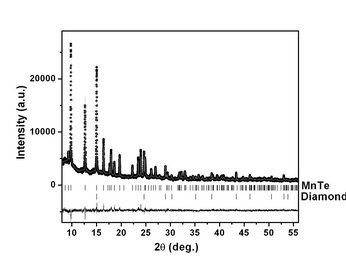| Search for content and authors |
Hexagonal MnTe with NiAs structure: thermal expansion coefficients and exchange striction |
| Wojciech Szuszkiewicz 1, Roman Minikayev 1, Elzbieta Dynowska 1, Barbara Witkowska 1, Anthony Bell 2 |
|
1. Polish Academy of Sciences, Institute of Physics, al. Lotników 32/46, Warszawa 02-668, Poland |
| Abstract |
Magnetic or diluted magnetic semiconductors have been intensively studied in the past, but recently, the possibility of applications in spin electronic devices has renewed the interest for this kind of materials, especially when they exhibit magnetic properties at room temperature. Among binary manganese compounds MnTe with a hexagonal crystal structure of NiAs type is particularly interesting because of its relatively high Neel temperature (TN = 310 K). The successful growth of such MnTe thin layers by molecular beam epitaxy [1] opened a possibility of potential applications of this material in multilayer structures. The expansion coefficients of materials constituting given structure belong to important parameters required for correct interpretation of the physical properties of considered multilayer. For magnetic materials details of the exchange striction are also of great interest. The relevant MnTe literature data published long time ago were limited to narrow temperature range from 170 K to 350 K only [2, 3]. Moreover, the authors of both mentioned papers demonstrated a sharp decrease of the c parameter value with decreasing temperature below TN unaccompanied by any significant change in the a parameter temperature dependence. This information was a little bit surprising taking into account a typical behaviour of other magnetic compounds also crystallizing in the hexagonal structure of NiAs type. The goal of present paper was to investigate the evolution of the MnTe lattice parameter values in a wide temperature range and to check the relevant information given in the literature. The determination of the linear expansion coefficient value at several hundreds Centigrades should be very helpful when considering possible growth of structures containing MnTe layers. In particular, the thermal strain resulting from different expansion coefficient values for the substrate and for the layer under interest when cooling the structure from the growth temperature to the room temperature can be estimated. On the other hand the numerical values of linear expansion coefficients at the low temperature range can be useful for possible analysis of the exchange striction, present below the magnetic phase transition temperature. The bulk, single MnTe crystals were grown at the Institute of Physics PAS in Warsaw. Their structure quality at room temperature was confirmed by the results of high-resolution X-ray diffraction measurements, performed with help of Panalytic X’Pert MRD diffractometer iat the same institute. For that purpose the CuKa1 radiation was applied, within the experimental accuracy possible presence of precipitates or secondary phases was excluded. The HT and LT measurements were carried out using a synchrotron radiation and taking advantage of a powder diffractometer installed at the B2 beamline at Hasylab/DESY in Hamburg. The samples were prepared as a mixture of powdered MnTe crystals and fine diamond powder. For sample mounting a thin-wall quartz or glass capillary was applied. During all measurements the capillary rotates inside a temperature chamber. The radiation wavelength (about 0.538 Å) was calibrated in situ, using the diamond. The 10 K – 1163 K temperature range was investigated. Structure analysis has been provided by using the Rietveld-refinement procedure (an example is shown on figure 1). The linear expansion coefficients were determined for the a(T) and c(T) dependences. At limited area of high temperature range a partial transformation of MnTe into MnTe2 (phase absent at RT) was observed, the supplementary phase vanished above 1043 K. Below TN value not only the c parameter, but also the a parameter exhibit a kink in its temperature dependence. The relative modification of the a parameter value is less pronounced than that corresponding to the c value but nevertheless well visible. Present low-temperature data are in general agreement with our previous neutron scattering data taken with slightly smaller accuracy a few years ago [4]. The observed modifications of lattice parameter values at low temperature resulting from the exchange interactions are compared with a few known, similar data obtained for other magnetic materials with the same type of crystal structure. A little bit surprising decrease of a distance between Mn ions observed in plane perpendicular to the hexagonal MnTe crystal axis in spite of the ferromagnetic exchange integral between the nearest neighbours in plane [5] is discussed. 
Fig. 1. The X-ray diffraction pattern collected at T = 40 K for investigated sample. Portions of this research were carried out at the light source DORIS III at DESY, a member of the Helmholtz Association (HGF). This work was partially supported by the research grant N N202 128639 from Ministry of Science and Higher Education (Poland) and by the EU under contract II-20100155.[1] E. Przeździecka, E.Kamińska, E. Dynowska et al., Phys. Stat. Sol. C 2, 1218 (2005). ________________________________ |
| Legal notice |
|
| Related papers |
Presentation: Poster at 17th International Conference on Crystal Growth and Epitaxy - ICCGE-17, Topical Session 2, by Wojciech SzuszkiewiczSee On-line Journal of 17th International Conference on Crystal Growth and Epitaxy - ICCGE-17 Submitted: 2013-04-15 22:04 Revised: 2013-07-17 23:17 |